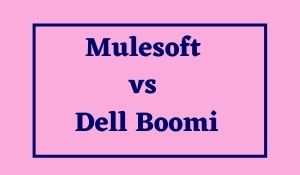
Over the last few years, the Integration Platform as a Service (iPaaS) air has grown and there are 2 leading technologies well agreed to air at: Dell Boomi and MuleSoft. The competition to be the number one integration support provider is fierce, and each company offers sure specific capabilities to habitat integration challenges.
MuleSoft’s Anypoint Platform
MuleSoft offers companies next-gen integration platforms. Their platform works in hybrid environments linking all the enterprise apps that sit both in the cloud and on-premise. Their Anypoint Platform is not an integrated platform solution. Companies are required to purchase multiple products and components, which could include:
- Anypoint Studio: a graphical, Java-based design environment that a developer can use to deploy APIs to on-premises and cloud environments. Anypoint Studio also includes features to map, build, edit and debug data integrations.
- Anypoint Connectors: a set of built-in connectors that a developer can use to integrate applications with thousands of third-party REST and SOAP.
- Anypoint Design Center: allows API developers to design and build APIs and
- Anypoint Exchange: is a library for API providers to share APIs, templates, and assets.
- Anypoint Management Center: is a centralized web interface to analyze, manage, and monitor APIs and integrations.
There are other components as well in the Anypoint Platform that may need to be considered, based on the scale and requirement of the projects.
Dell Boomi
Dell Boomi is focused on becoming the first company to devise wholly ‘Connected Businesses’. Unlike Mulesoft, Boomi is an all-in-one platform. The main components for Boomi’s Atmosphere include:
- Application/data integration
- API management
- B2B/EDI management
- Master data management
- Flow which is Low-code workflow automation and application development
Licencing is based on feature usage of the platform. So, which integration platform is best between Boomi and Mulesoft? Below, we’ll discuss how the 2 platforms compare to each other.

Key Features: MuleSoft vs. Dell Boomi
Boomi and Mulesoft have many similar features. In the following sections, we’ll look at how Dell Boomi and Mulesoft compare in terms of cost, technical capabilities, API management, and platform features.
| Dell Boomi | MuleSoft | |
| Database replication | Full table | Incremental replication depends upon manually written SELECT statements |
| Pre-built SaaS Sources | ~80 | ~70 |
| Add new data sources? | Yes | Yes |
| Data warehouse connections | Yes | No |
| Data lake connections | Yes | Yes |
| Pricing model | Monthly or annual | Annual only |
| Developer tools | AtomSphere API for programmatic control of the AtomSphere platform, Connector SDK for writing custom connectors | Runtime Manager REST API, CloudHub API |
| Versioning | Built-in version control | 6 different versions of a Runtime Engine |
| Coding | Low-code | Heavy coding required |
| Smart Data Mapping | Yes | No |
Choosing Between Boomi and MuleSoft
MuleSoft and Boomi are both good choices for businesses wanting to integrate many disparate systems together. As demand for integration platform specialists grows, more and more aspiring IT teams are leaning towards implementing Boomi. Since Boomi is less complicated and more feature-friendly than MuleSoft, learning, or commercially applying the Boomi platform seems to be easier and faster. With over 10,000 businesses already using Boomi, it’s clear why it’s ranking high on the Magic Quadrant.
Pros and cons
Dell Boomi Pros
- Pre-built connectors to almost anything which greatly reduces time to release your integration needs.
- Easy to use development platform with drag and drop features. Non-technical people could build the simple integration processes in no time.
- Great user community where you can get quick help if needed. Boomi people hang around there a lot.

MuleSoft Pros
- It is best suited for Rest API development. It uses RAML as an API descriptor which is less complex and easy to understand. RAML is an open standard mainly supported by Mulesoft. Once RAML is developed, it’s very easy (a few clicks) to create flows corresponding to the resources defined in the RAML. One can also include JSON schema validation in RAML, and with the use of API kit router, Mule ESB makes the request validation very easy.
- Mule ESB comes with the large spectrum of community and enterprise connectors. They have connectors for all the major platforms like Facebook, Twitter, Salesforce, SAP, etc. This enables Mule ESB to integrate with other systems in a faster and more robust way. Mule ESB have many components to fulfill the requirements of each integration (for example batch processing, parallel processing, choice, etc.)
- Mule API gateway is one of the best tools of Mulesoft’s. It supports the API governance and management very well. One can easily enforce the policies on their APIs with API gateway.
Dell Boomi Cons
- The dashboards are limited
- Running Low latency improves the performance but makes the resolving issues very difficult
- Unable to sign up for alerts for one process only. Alerts go out at an account level. If you want to get notifications for a process you need to build it into your application.
- The folder structure of components can get messy if not well-governed.
- Scripting could be improved. You don’t know if you have errors in your code until you run the process.
MuleSoft Cons
- Make sure to not over-engineer shared components. It can complicate development
- Create a roadmap for where you are going – if not, you may miss components
- I suggest getting support, otherwise, it could be a difficult learning curve
Conclusion: If you or your organization wants to learn more about Dell Boomi or Mulesoft. GoLogica is offering an instructor-led Mulesoft ANYPOINT Training and Dell Boomi Training. Mulesoft ANYPOINT course aims at teaching SaaS and enterprise applications on Cloud platforms. By the end of the course, you should be able to understand the concepts of Mulesoft ANYPOINT and how and where it is used.
